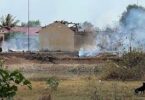KYIV: Ukraine’s commander-in-chief has outlined a plan to massively scale up the use of unmanned systems to overcome Russia’s advantages in manpower and materiel and break the deadlock in this war. The effectiveness of such systems was proved again last week as they sank a Russian missile corvette, grounded three planes and set an oil refinery on fire.
Russia, too, continued to attack Ukraine with drones and missiles, but it failed to capture new territory despite its superior resources and constant assaults on the eastern city of Avdiivka and Ukraine’s stronghold at Krynky on the left bank of the Dnipro River in the Kherson region. Meanwhile, Ukraine’s Western allies made progress on securing funding for the war.
The European Union finally approved a 50-billion-euro ($63bn) aid package for Ukraine, and the United States Senate unveiled a $118bn bill that includes $60bn for Ukraine. “Unmanned systems … are almost the only tool for withdrawing from military operations of a positional form,” Ukrainian commander-in-chief Valerii Zaluzhny wrote in a doctrinal paper on Thursday, because traditional heavy armour and manpower are “increasingly a dream” for Ukraine’s armed forces.
He called for a “completely new state system of technological rearmament” that could “take up to five months”. Zaluzhny’s new military doctrine dovetailed with the government’s pledge late last year to build 1 million first-person viewer drones and 11,000 medium- and long-range drones this year. Ukraine has used such systems with devastating effect. On January 31, Ukraine struck the Belbek airfield in western Crimea. Russia’s Ministry of Defence said it intercepted 20 air-launched missiles, but Russians in Crimea filmed some of the missiles flying undisturbed directly over dormant air defence systems.
The following day, Ukraine struck Belbek again, this time damaging or destroying three Russian fighter planes on the ground, according to southern forces spokesperson Natalia Humenyuk. One Russian military reporter described it as a complex, two-day operation targeting three airfields and involving decoy missiles, HARM radar-seeking missiles, Storm Shadow attack missiles and surface drones. Those surface drones sank a Russian warship near Lake Donuzlav off western Crimea.
Footage released by Ukraine’s armed forces showed them repeatedly striking the Ivanovets, a 480-tonne missile corvette, crippling it and then destroying it in a pair of massive explosions. It was reportedly one of only three still operating in Russia’s Black Sea Fleet. Ukrainian military intelligence chief Kyrylo Budanov said his service’s drone unit Group 13 sank the Ivanovets using Magura V5 surface drones. “There were six direct hits to the hull. … The ship overturned on its stern and sank,” he said.
Two days later, Ukraine’s Security Service struck the Rosneft refinery in Volgograd, one of the largest in Russia, apparently using two aerial drones. Footage showed at least four burning oil tanks destroyed. Budanov said he believes the number of attacks would increase. “Hypothetically, there is a plan by which all this happens. I believe that this plan includes all the main objects of critical infrastructure and objects of military infrastructure of the Russian Federation,” Budanov said.
Ukrainian air force spokesman Yuri Ignat suggested attacks on Crimea would continue to target airfields. “Russia uses not only Belbek. About five airfields are actively used for attacks on Ukraine. These are planes of various modifications: MiG-31, … MiG-29, Su-27 and helicopters,” he said. Ukraine has pursued other forms of asymmetric warfare.
Its military intelligence said a Russian Tu-95 bomber, who had reportedly taken part in raids on Ukraine, was shot dead in Russia. Ukrainian hackers from the Prana Network broke into a Russian Defence Ministry server, stealing documents that revealed Russia had agreed to pay Iran $1.75bn for 6,000 Shahed drones. Russia kept those drones flying into Ukraine throughout the week, accompanied by missiles. — Aljazeera







